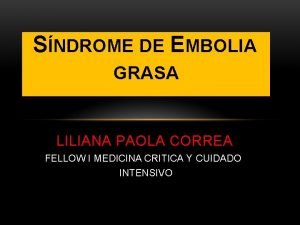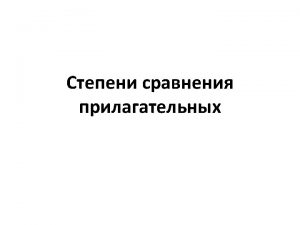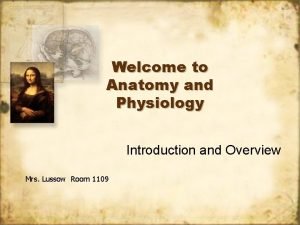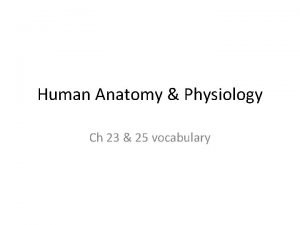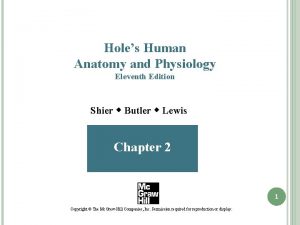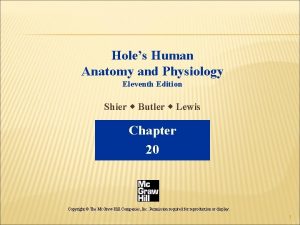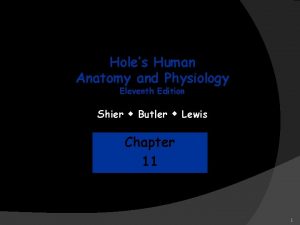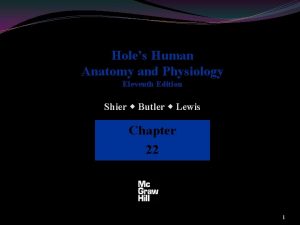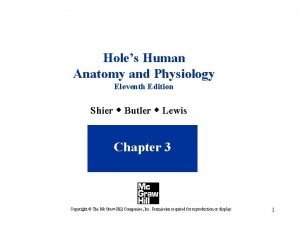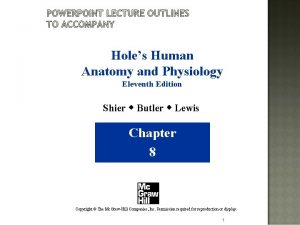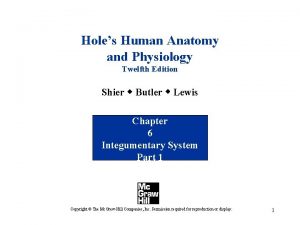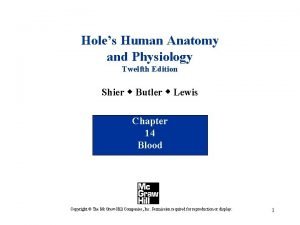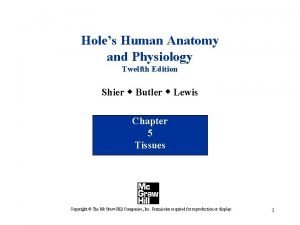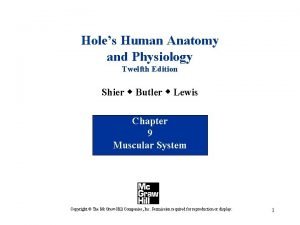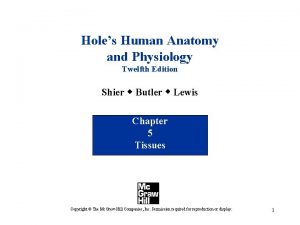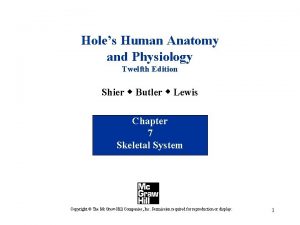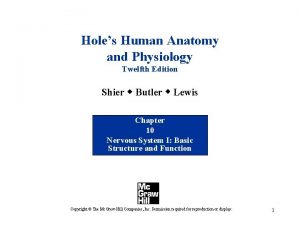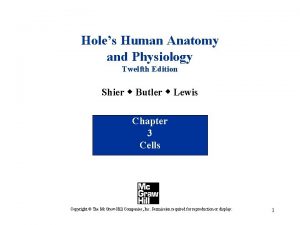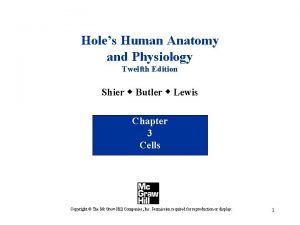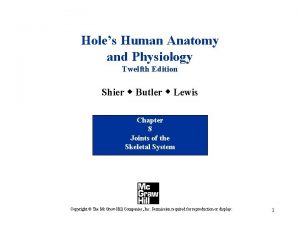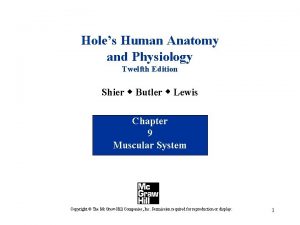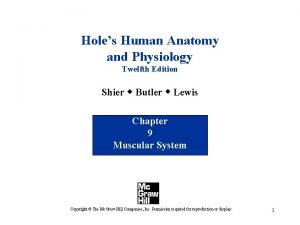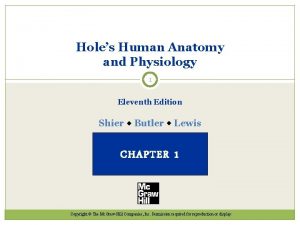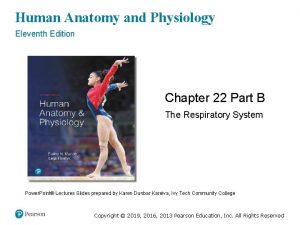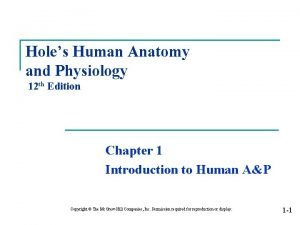Holes Human Anatomy and Physiology Eleventh Edition Shier

































































- Slides: 65

Hole’s Human Anatomy and Physiology Eleventh Edition Shier w Butler w Lewis Chapter 11 The Nervous System II Divisions of the Nervous System: The Brain Copyright © The Mc. Graw-Hill Companies, Inc. Permission required for reproduction or display.

Brain Development 1. Embryonic neural tube expands and hollows cranially 2. Three vesicles develop that split and become four adult ventricles 3. The walls of the three vesicles become certain adult brain areas –Forebrain = Cerebrum, basal nuclei, & diencephalons –Midbrain = Midbrain –Hindbrain = Pons, medulla, obloongata, & cerebellum

The Brain n n 4 Portions: cerebrum, cerebellum, diencephalon and brain stem Functions: – – – Interprets sensations Determines perception Stores memory Reasoning Makes decisions Coordinates muscular movements – Regulates visceral activities – Determines personality

Structure of the Cerebrum n Cerebrum: the largest portion of the brain; two cerebral hemispheres – Corpus callosum: nerve fibers that connect the hemispheres – Convolutions (gyri): surface ridges – Lobes divide the hemispheres: frontal, parietal, temporal and occipital – Tyo types of grooves: n n Sulci: shallow Fissure: deep


Lobes of Cerebral Hemispheres



*Somato-sensory Cortex “Post-central gyrus”









Functions of the Cerebrum n Functions – – – n Interpreting impulses Initiating voluntary movements Storing information as memory Retrieving stored information Reasoning Seat of intelligence and personality Composition – Bulk white matter (bundles of myelinated nerve fibers, by oligodendrocytes) – Cerebral cortex (outer portion) is gray matter, bundles of neuron cell bodies




Central Sulcus Precentral Gyrus Postcentral gyrus Parietal Lobe Frontal lobe Lateral Fissure Occipital lobe Temporal lobe Cerebellum

Frontal Lobe Longitudinal Fissure Precentral Gyrus Central Sulcus Postcentral Gyrus Parietal Lobe Gyrus Occipital Lobe Sulcus

Corpus callosum Thalamus Pineal gland Parietal Frontal Sup. Colliculus (midbrain) hypothalamus C. Aquaduct Mammilary body Occipital Inf. Colliculus (Midbrain) Cerebellum Optic chiasma Pituitary Cerebral Penduncle (midbrain) Pons 4 th ventricle Medulla Oblongata


frontal Cranial nerves Optic chiasma Pituitary gland Temporal lobe Mammillary body pons Medulla oblongata cerebellum





Composition n Bulk of cerebrum is white matter – Bundles of myelinated nerve fibers (by oligodendrocytes) n Cerebral cortex (thin layer, outer portion) is gray matter – Bundles of neuron cell bodies (75% of all neurons in NS) – Recordings of activity or brain waves

Functions of Cerebrum n All conscious behavior via 3 functional areas: sensory, association areas and motor

Sensory Areas n Conscious awareness of sensations: – Primary Somatosensory Cortex n n parietal lobe sensations on skin – Visual (Cortex) Area n n occipital lobe interprets vision – Auditory (Cortex) Area n n temporal lobe interprets hearing – Gustatory Cortex n n near bases of the central sulci Taste – Sensory Area for smell n arise from centers deep within the cerebrum

Sensory Areas

Association Areas n General – Areas not directly involved in motor or sensory function – Involved in many traits (analyze, memory, judgement…) – Interconnected – Involve all four lobes – See table 11. 5, page 405

Association Areas Frontal Lobe Association Areas • concentrating • planning • complex problem solving http: //www. philly. com/philly/health/20150201_Te ens__immature_brains_pose_all_sorts_of_danger s. html#pkft 0 p. G 44 AUUWlc. K. 03 Parietal Lobe Association Areas • understanding speech • choosing words to express thought Temporal Lobe Association Areas • interpret complex sensory experiences • store memories of visual scenes, music, and complex patterns Occipital Lobe Association Areas • analyze and combine visual images with other sensory experiences Insular Cortex • empathy and emotion • pain levels

Association Areas

Memory and Emotion (Temporal Lobe) Lower portion of Corpus Callosum connects to hippocampus = memory us la, s ll goe Sme ygda to am halam not t connects to hippocampus = memory Emotional center Memory Mammillary - Fornix – Hippocampus - Amygdala

Functional Regions of Cerebral Cortex n n Hemisphere Dominance (Brain Lateralization): most basic functions are controlled by both left and right hemispheres (communication exists thru corpus callosum) Memory – A consequence of learning whereas learning is the acquisition of new knowledge, memory is the persistence of learning n n n Short Term Long Term A lesion in the cerebral cortex could cause – Motor or sensor deficits – Intellectual impairment – Strange behavior in thought patterns

Hemisphere Dominance • The left hemisphere is dominant is most individuals • Dominant hemisphere controls • speech • writing • reading • verbal skills • analytical skills • computational skills • Nondominant hemisphere controls • nonverbal tasks • motor tasks • understanding and interpreting musical and visual patterns • provides emotional and intuitive thought processes



Memory Short Term • working memory • closed neuronal circuit • circuit is stimulated over and over • when impulse flow ceases, memory does also • unless it enters longterm memory via memory consolidation • 1 st stage Long Term • changes structure or function of neurons • enhances synaptic transmission

Motor Areas • Primary Motor Areas • frontal lobes • control voluntary muscles • Broca’s Area • anterior to primary motor cortex • usually in left hemisphere • controls muscles needed for speech • Frontal Eye Field • above Broca’s area • controls voluntary movements of eyes and eyelids

Motor Areas


Basal Nuclei n n n Masses of gray matter Deep within cerebral hemispheres “Relay stations, ” for outgoing motor impulses from the brain Produces dopamine Aids in control of motor (muscular) activities – primarily by inhibiting motor functions n Clinical Application pg. 11. 5 Parkinson’s and Huntingdon’s disease result from the degeneration of the basal ganglia Movement disorders – Parkinsons, Huntingtons, Tourettes, OCD



Diencephalon n Between cerebral hemispheres and above the brainstem surrounds third ventricle n Thalamus (gray matter) Hypothalamus (gray matter) Optic tracts Optic chiasma Infundibulum Posterior pituitary Mammillary bodies Pineal gland n n n n

Diencephalon n Thalamus – gateway for sensory impulses heading to cerebral cortex – receives all sensory impulses (except smell) – channels impulses to appropriate part of cerebral cortex for interpretation n Hypothalamus – forms part of the diencephalon – Main visceral control center of the body (i. e. regulates homeostasis) n n n Heart rate & blood pressures Body temperature Water and electrolyte balance Control of hunger, body weight, digestive movements & secretions Regulation of sleep-wake cycles Control of endocrine system functioning

Diencephalon n a) b) c) d) e) f) Limbic System = involved in Emotional response also includes structures in the frontal and temporal cortex, basal nuclei, and deep nuclei controls emotional experience and expression can modify the way a person acts produces feelings of fear, anger, pleasure, and sorrow recognizes life threatening upsets in a person's physical or psychological condition and counters them involved in sense of smell.

Brain Stem Three Parts: 1. Midbrain 2. Pons 3. Medulla Oblongata Serves as a pathway for fiber tracts running to (sensory impulses) and from (motor impulses). The cerebrum and brain stem is the site where many cranial nerve arise (PNS)

Midbrain n n Between diencephalon and pons Corpora quadrigemina = 4 dome-like protrusions on the dorsal midbrain surface Gray matter within white matter Acts in reflex actions (visual and auditory) Contains areas associated with reticular formation.


Pons n n bulging portion of brain stem "bridge" or pathway of conduction tracts location of pneumotaxic area (regulation of breathing rate) of respiratory center also contains areas associated with reticular formation.

Medulla (Oblongata) n n Inferior part of brain stem, blends into the spinal cord at its base Contains an autonomic reflex center involved in maintaining homeostasis of important visceral organs. – – Cardiac center – force and rate of heart contraction Vasomotor center – blood pressure – acts on smooth muscles in arterioles Respiratory center – depth and rhythm of breathing Add’l involuntary activities: vomiting, hiccuping, swallowing, sneezing, coughing.

Reticular Formation n n complex network of nerve fibers (gray matter) scattered throughout the brain stem extends into the diencephalon connects to centers of hypothalamus, basal nuclei, cerebellum, and cerebrum filters incoming sensory information arouses cerebral cortex into state of wakefulness

Types of Sleep Slow Wave Rapid Eye Movement (REM) • 90 min • lasts 15 min • non-REM sleep • paradoxical sleep • person is tired • some areas of brain active • decreasing activity of • heart and respiratory rates reticular system irregular • restful • dreaming occurs • dreamless • reduced blood pressure and respiratory rate • ranges from light to heavy • alternates with REM sleep

Cerebellum • inferior to occipital lobes • posterior to pons and medulla oblongata • two hemispheres • vermis connects hemispheres • cerebellar cortex – gray matter • arbor vitae – white matter • cerebellar peduncles – nerve fiber tracts • dentate nucleus – largest nucleus in cerebellum • integrates sensory information concerning position of body parts • coordinates skeletal muscle activity • maintains posture

Skull bone Meninges brain Cause: Inflammation of the meninges. Can be caused by a virus or bacteria and can be extremely harmful and contagious. Symptoms: stiff neck, sore back, light irritation, nausea, body aches, sleepy, confused, fever

Brain Function Summary Table n Define the Location/Characteristics and Functions for the following parts: – Cerebrum n n n n Primary Motor Cortex Broca’s Area Primary Somatosensory Cortex Visual Cortex Auditory Cortex Gustatory Cortex Association Areas – Basal Nuclei – Diencephalon n n Thalamus Hypothalamus – Brain Stem. Midbrain n n Pons Medulla Oblongata – Cerebellum



 Holes essential of human anatomy and physiology
Holes essential of human anatomy and physiology 3 layers of muscle
3 layers of muscle Uterus perimetrium
Uterus perimetrium Holes anatomy and physiology chapter 1
Holes anatomy and physiology chapter 1 Anatomy and physiology edition 9
Anatomy and physiology edition 9 Eleventh edition management
Eleventh edition management Management eleventh edition
Management eleventh edition Management eleventh edition
Management eleventh edition Management eleventh edition
Management eleventh edition Waistline
Waistline Chapter 1 introduction to anatomy and physiology
Chapter 1 introduction to anatomy and physiology Chapter 2 human reproductive anatomy and physiology
Chapter 2 human reproductive anatomy and physiology Peter shier
Peter shier Escala de shier
Escala de shier степени сравнения shy
степени сравнения shy Human anatomy fifth edition
Human anatomy fifth edition Human anatomy fifth edition
Human anatomy fifth edition Physiology of sport and exercise 5th edition
Physiology of sport and exercise 5th edition Bhore committee
Bhore committee Eleventh 5 year plan
Eleventh 5 year plan Eleventh plan
Eleventh plan For his eleventh birthday elvis presley
For his eleventh birthday elvis presley Physiology of respiration
Physiology of respiration Tattoo anatomy and physiology
Tattoo anatomy and physiology International anatomy olympiad
International anatomy olympiad Imperfect flowers examples
Imperfect flowers examples Anatomy and physiology bones
Anatomy and physiology bones Ulcer definition anatomy
Ulcer definition anatomy Liver hilus
Liver hilus Hypogastric region
Hypogastric region Hypogastric region
Hypogastric region Straw colored fluid
Straw colored fluid The central sulcus divides which two lobes? (figure 14-13)
The central sulcus divides which two lobes? (figure 14-13) Http://anatomy and physiology
Http://anatomy and physiology Physiology of appendicitis
Physiology of appendicitis Aohs foundations of anatomy and physiology 1
Aohs foundations of anatomy and physiology 1 Aohs foundations of anatomy and physiology 2
Aohs foundations of anatomy and physiology 2 Anatomy and physiology of swine
Anatomy and physiology of swine Anatomy and physiology chapter 8 special senses
Anatomy and physiology chapter 8 special senses Chapter 13 anatomy and physiology of pregnancy
Chapter 13 anatomy and physiology of pregnancy Unit 26 self evaluation answers
Unit 26 self evaluation answers Science olympiad forensics cheat sheet
Science olympiad forensics cheat sheet Anatomy and physiology chapter 2
Anatomy and physiology chapter 2 Anatomy and physiology of stomach ppt
Anatomy and physiology of stomach ppt Pancreas anatomy and physiology
Pancreas anatomy and physiology Heat and cold
Heat and cold Anatomy and physiology coloring workbook chapter 14
Anatomy and physiology coloring workbook chapter 14 Chapter 10 blood anatomy and physiology
Chapter 10 blood anatomy and physiology Aohs foundations of anatomy and physiology 1
Aohs foundations of anatomy and physiology 1 Aohs foundations of anatomy and physiology 1
Aohs foundations of anatomy and physiology 1 What produces bile
What produces bile Anatomy and physiology chapter 15
Anatomy and physiology chapter 15 Cornell notes for anatomy and physiology
Cornell notes for anatomy and physiology Anatomy and physiology chapter 1
Anatomy and physiology chapter 1 Anatomy and physiology unit 7 cardiovascular system
Anatomy and physiology unit 7 cardiovascular system Gi tract histology
Gi tract histology Anatomy and physiology
Anatomy and physiology Aohs foundations of anatomy and physiology 1
Aohs foundations of anatomy and physiology 1 Aohs foundations of anatomy and physiology 1
Aohs foundations of anatomy and physiology 1 Olecranal region
Olecranal region Anatomy and physiology exam 1
Anatomy and physiology exam 1 Welcome to anatomy and physiology
Welcome to anatomy and physiology Anatomy and physiology of the foot
Anatomy and physiology of the foot Integumentary system psoriasis
Integumentary system psoriasis Pancreas anatomy histology
Pancreas anatomy histology Anatomy and physiology vocabulary
Anatomy and physiology vocabulary













